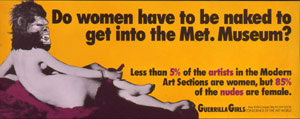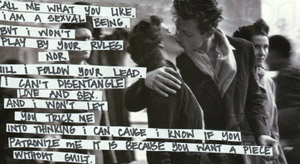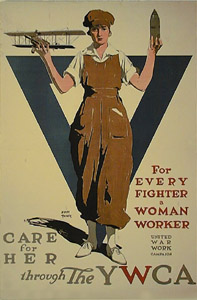








Exhibition Schedule - Spring 1998
| January 26 - February 18 | WACK-O:
Extreme Politics
and the Poster Guerrilla Girls Talk Back: The First Five Years (1985 - 1990) |
| February 25 - March 18 |
|
| March 26 -
April 17 |
Hurricane Voices and Sacred Hands |
| April 28 - June 8 |
|
WACK-O: Extreme Politics and the Poster
 An exhibition of contemporary political posters from the United States organized by Donald Moffett is presented in the interior galleries. Spanning the last thirty years, the exhibition explores a wide variety of social, political, and cultural issues including gender- and race-related rights, sexuality, AIDS, queer politics, reproduction politics, censorship and the arts, war, public housing, and animal rights. Moffett writes: The political poster, as an art form, is the giant equivalent of the greeting card. It floats weightlessly above (or below) academic ritual, rigor, or training. It mocks conservation and archival ambition and sluts around as ephemera. It has no market muscle. It is greased by hyperbole and can reek of sentiment. But, unlike the personal scale and 1-on-1 format of a Hallmark card, the poster is made for a crowd. Unlike the intimate whisper of a card, it strips for the back row. Reckless and cheap, it is the grand pedestrian slate for deep emotions and, most unlike its dime store midget cousin, the fierce place of politics. In WACK-O, the political poster stands as a firewall between political camps--isolating both, defining the factions, and leveling or neutralizing the inevitable balance of power. The organizational logic is simple; either the poster flaunts a seemingly extreme posture (e.g. Fierce Pussy's "Read My Lips" and Bob Flanagan's "Fight Sickness with Sickness"), or it acts out in self-defense against a perceived extremism (e.g. Barbara Kruger's "Your Body is a Battleground" or Bethany John's "Keep Your Rosaries Off My Ovaries"). In this teetering pack of humorists, satirists, libertarians, malcontents, and bullies, "extreme" is exposed as subjective, fluid, unstable, unpredictable, and--like us--is vulnerable to fickle fate and time. "Extreme" like "beautiful" depends on your mood or your morals or your politics. WACK-O is All-American: in its issues, its challenges, and maybe most tellingly, its comfort with the very radical notion of free speech. Born or adopted into this constitutional right, the participants (including the viewers) will flex their entitlement, occasionally trample civility, and in the process test and re-test this stubbornly democratic and artful principle. Although wounded by higher-tech forms of free speech, as the voice of the people drifts to public-access cable TV and the global interment "chat room," the political poster won't be stopped. It will forever be the soapbox whore to every pathetic economy and penny ante photo copyist. With the twisted precision of a tax form, it will perennially commandeer your space--sapping or fortifying your strength, stomping or stroking your ego, fingering your fears, messing with your assumptions--all in the name of freedom. Welcome to the fray. The exhibition includes work by ACT
UP, Robbie Conal, Gran Fury, Keith Haring, Jenny Holzer, Les Levine,
Sister Corita Kent, Marlene McCarty, the Negro Art Collective, and others.
 The portfolio Guerrilla Girls Talk Back: The First Five Years (1985-1990) is presented in the hallway gallery. The thirty-one offset lithographs in the portfolio include such posters as Dearest Art Collector; Guerrilla Girls’ Definition of a Hypocrite; Women in America earn only 2/3 of what men do/Women artists earn only 1/3 of what men artists do; and The Advantages of Being a Woman Artist (“Not being stuck in a tenured teaching position,” “Seeing your ideas live on in the work of others,” “Having the opportunity to choose between career and motherhood”). Posters like these originally appeared wheat-pasted to telephone poles, fences, and buildings in New York’s SoHo where they became part of the visual collage of the city; these works now often make their appearance in an entirely different setting, that of a university art gallery or public museum. Self-proclaimed consciences of the art world, the Guerrilla Girls is a group of anonymous women artists and art professionals who target museums, galleries, and collectors for exhibiting and collecting artwork based primarily on the Western male-centered artistic canon. Increasingly, their attention has focused on the media and the reluctance of critics and editors to cover women artists and artists of color. Over the past twelve years, they have produced various posters, postcards, and a book, Confessions of the Guerrilla Girls, which tackle issues of sexism and racism in the art world. Most recently they have established a presence on the internet at www.guerrillagirls.org. Special thanks to Joost de Laat ’98, Jennifer Farrell ’98, Kyle Gardner
’98, Denise LaVine ’00, Rebecca Kush ’99, and Cristianne McKenna ’99 for
designing and installing the exhibition, and Tonki Reidy ’96 for research
assistance.
Creative Responses to Global Warnings
 Artists represented in the exhibition include Anna Gerhard Arnold, Mae Bigtree and Celia Jock,Velma Bolyard, Prilla Smith Brackett, Clyde Butcher, Becky Harblin, Sandy Hildreth, Sam Kittner, Vera Ponko, Carol Rubsamen, Clint Shenandoah, and Jaune Quick-to-See Smith. Also participating will be students from St. Lawrence University, and students from the classes of Rich Hammill at Colton-Pierrepont Central School, Sally Hartman at Heuvelton Central School, Kathy Kortz at Thousand Islands Community School, Becky Milone at Clifton-Fine Central School, Sandy Hildreth at Madrid-Waddington Central School, Jean Hamilton at Edwards-Knox Central School, and Marti Ricci of Liberty Partnership/Tropical Rainforest Outreach Program at Watertown High School and Jefferson Community College. top of page Hurricane Voices and Sacred Hands
 Can we look at the images and texts that fill our environment and see what is not there? Whenever we speak, perform, or create in the present, we make choices about what to include, what to question, what to forget, and what to disguise from the past. For over 500 years, since the first modern contacts by Europeans with the Americas, Africa, and Asia, an official Eurocentric history has uneasily coexisted with (counter)narratives and (counter)knowledges that were ignored in dominant discourse in the West. What other visions could emerge? Can we help each other tell different stories? SLU students in two Cultural Encounters courses were asked to create visual and literary works that shift our perspectives on surrounding images and honor what has been dishonored in the past. Like a hurricane, creativity can disrupt and rearrange whatever is normalized. With sacred hands, ruptured histories, environments, and communities can be healed.  The Washington-based Riot Grrls! organized in response to the male domination of the late '80s youth punk scene. Not only interested in forming all-girl bands, Riot Grrls! and other young women became politically active, organized meetings, and reached out to each other and other girls through fanzines. The zines were a powerful and accessible form of communication; photocopied and distributed often by hand, these publications carry in-your-face messages and often a rough appearance that is as much a sign of their informality as it is a message of the writers' breaks with convention. As the popular press in the nineteenth century provided wider-scale access to publication opportunities for women, the net has opened up a broad audience for many, including zine writers, contributing to the national popularity of some zines. The zines too have an antecedent in the underground, feminist texts of the 1970s which were run off, stapled and distributed by feminist groups. The zines written for the SLU First-Year Program college, Grrl! Talk,
are mindful of the historical connection of feminist activism through varied
types of publications and are also fresh and young in the spirit of the
zine movement. The voices in the zines from Grrl! Talk, like the voices
in the zine movement, are as varied in tone, focus and subject as young
women themselves.
—Mary Barkley and Anne Mamary
top of page Recent Acquisitions from the Permanent Collection

A significant portion of the collection has been given to the University through gifts from generous St. Lawrence alumni. Works of art are also purchased every year through funds generated from the Griffiths Endowment, and two endowments set up by Richard F. Brush, Class of 1952 - the Gilbert and Kane Endowments. Many of the works in this exhibition were acquired by the recommendation of SLU faculty for teaching purposes. For example, in recent years Professor Roger Bailey in Fine Arts has coordinated a series of artists-in-residence with Jack Beal and Sandra Freckelton, in which the two artists come to campus to create hand-colored lithographs. Copies of these prints were later donated to the University. Dr. Steven White in Modern Languages facilitated the purchase of the gouache painting by visionary artist, Pablo Amaringo, through the professor's Brazilian colleague, Dr. Luis Eduardo Luna. Luna is organizing an exhibition of visionary art for the Gallery to be presented in the spring of 1999. Dr. David Lloyd recommended the purchase of a series of 14 photographs of female genital mutilation in Kenya by Stephanie Welsh for students and faculty in African Studies. A University tripartite Collections Development Committee makes formal
recommendations regarding acquisitions and helps identify long-range collecting
goals that are in keeping with the functions of a teaching collection.
In the last nine years, the Gallery has had two primary goals in terms
of acquisitions. We have made a concerted effort to diversify the
collection by acquiring works by women and artists of color. Like
many institutional collections in this country, ours was at least 95% white
and male at the end of the 1980s. We have also focused on photography
as a medium in which to expand and strengthen the collection. With
a solid foundation of holdings of important photographs of the 20th century,
the University has acquired almost 200 additional photographs through gifts
and purchases since 1990. Recent purchases of works by artists such
as Bill Gaskins, Carole Gallagher, Nan Goldin, and Adrienne Salinger exemplify
our decision to address these goals.
Barnes Endowment Annual Juried Student Art Exhibition
top of page From Litho Stone to Pentium Chip: Interpreting Gender in U.S. World War I Posters
 top of page
Gallery Hours
The Gallery will be closed March 14 - 21 for spring break, but open
by appointment for individual or group visits.
|